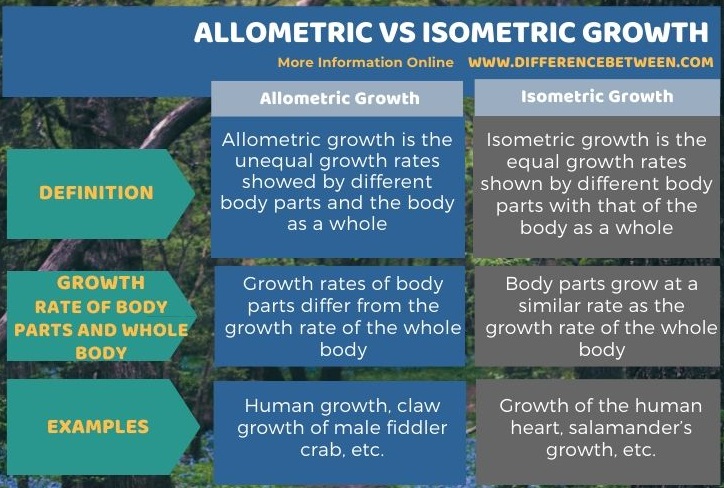Difference Between Allometric and Isometric Growth
The key difference between allometric and isometric growth is that allometric growth refers to the unequal growth rate in different parts of the body in comparison to the growth rate of the body as a whole while isometric growth refers to the equal growth rate of body parts in comparison to the growth rate of the body as a whole.
Allometric growth and isometric growth are two types of relationships between the growth rates of different body parts in comparison to the growth rate of the whole body. In allometric growth, the growth rates of different body parts differ from that of the whole body. In contrast, in isometric growth, body parts grow at the same rate as the rest of the body. In short, the growth rate is unequal in allometric growth while it is equal in isometric growth.
CONTENTS
1. Overview and Key Difference
2. What is Allometric Growth
3. What is Isometric Growth
4. Similarities Between Allometric and Isometric Growth
5. Side by Side Comparison – Allometric vs Isometric Growth in Tabular Form
6. Summary
What is Allometric Growth?
Allometry is the study of how the characteristics of an organism change with the size. In simple words, it is the study of the relationship between the size of a body part and the size of the body as a whole. Allometric growth refers to the unequal growth rate in different parts of the body in comparison to the growth rate of the body as a whole. It happens when the growth of a particular body part or structure shows a greater rate constantly than the growth rate of the whole body. Therefore, allometric traits grow at a different rate than the body as a whole.

Figure 01: Male Fiddler Crab
For example, the growth of the brain shows an allometric growth compared to body size. Another example is the growth of chela (claw) of the male fiddler crab. Chela is growing at a faster rate than the rest of the body. Hence, male fiddler crab has a giant claw while the other is in normal size. This giant claw helps them to attract females and fight with males. Moreover, the skeleton of mammals shows allometric growth.
What is Isometric Growth?
Isometric growth refers to the equal growth of all body parts. In other words, the growth rates of different body parts show a similar rate with the growth rate of the whole body. Therefore, the organs grow at the same rate as the rest of the body. They maintain a constant proportionate size throughout their development. Therefore, the adult proportions are not significantly different from those of the juvenile. For example, the growth rate of our heart is more or less isometric. Moreover, salamanders belonging to the genus Batrachoseps show an isometric growth.
What are the Similarities Between Allometric and Isometric Growth?
- Allometric growth and isometric growth are two types of relationships between the growth rates of different body parts in relation to the growth rate of the body as a whole.
- Living organisms show both types of growth during their development.
What is the Difference Between Allometric and Isometric Growth?
Growth rates of body parts differ from the growth rate of the whole body in allometric growth. In contrast, body parts grow at a similar rate with the growth rate of the whole body in isometric growth. Therefore, this is the key difference between allometric and isometric growth. Considering some examples, human growth and claw growth of male fiddler crab are two examples of allometric growth, while the growth of the human heart and salamanders’ growth are two examples of isometric growth.
Below infographic summarizes the difference between allometric and isometric growth.

Summary – Allometric vs Isometric Growth
In allometric growth, different organs or structures grow in different rates in comparison to the growth rate of the whole body. In isometric growth, organs grow at the same rate as the body growth. So, this is the key difference between allometric and isometric growth. Human growth is an example of allometric growth while salamander growth is an example of isometric growth.
Reference:
1. “Allometry: The Study of Biological Scaling” Nature News, Nature Publishing Group, Available here.
2. “Timing Is Everything: Morphogenesis, Heterochrony and Evolution.” Heterochrony, Available here.
Image Courtesy:
1. “West African fiddler crab (Uca tangeri) male” By Charles J Sharp – Own work, from Sharp Photography (CC BY-SA 4.0) via Commons Wikimedia
ncG1vNJzZmivp6x7pbXFn5yrnZ6YsqOx07CcnqZemLyue8OinZ%2Bdopq7pLGMm5ytr5Wau26ty6Wmpp2kp7akecCnm2aho6S6psDRoppmn6KkxLW0jg%3D%3D